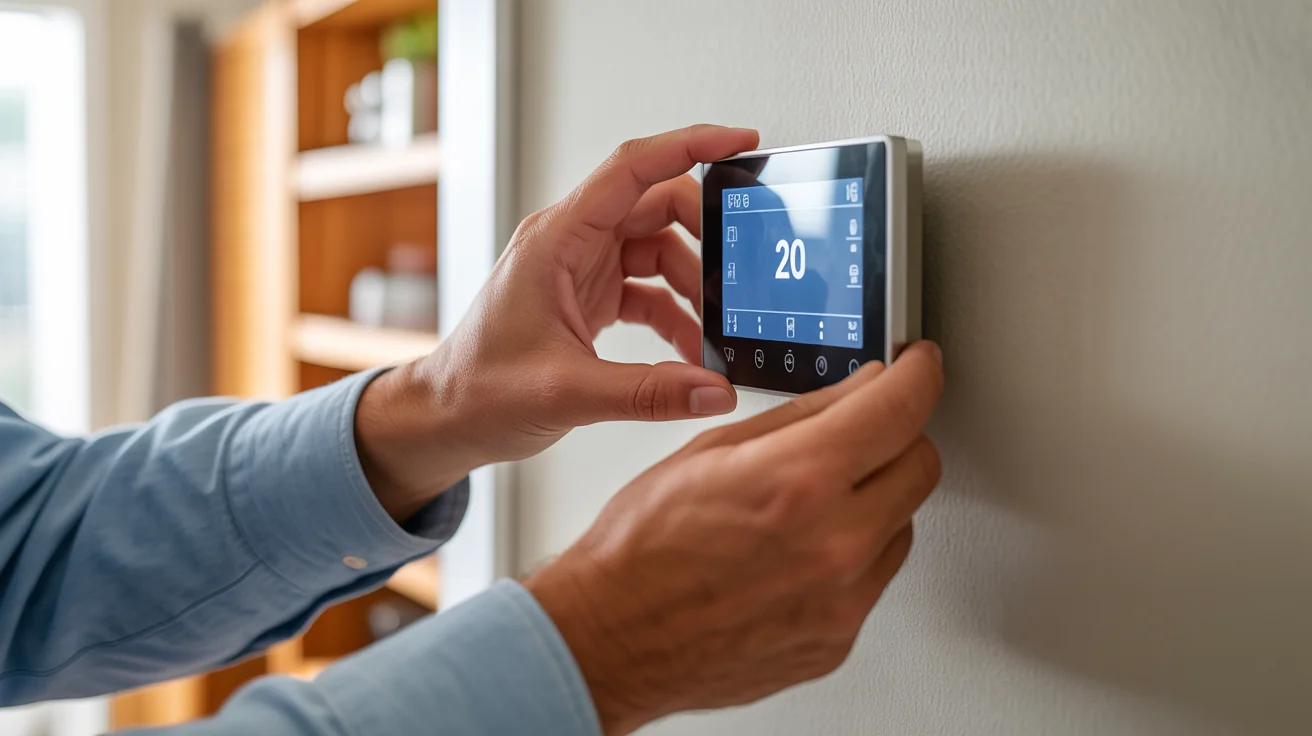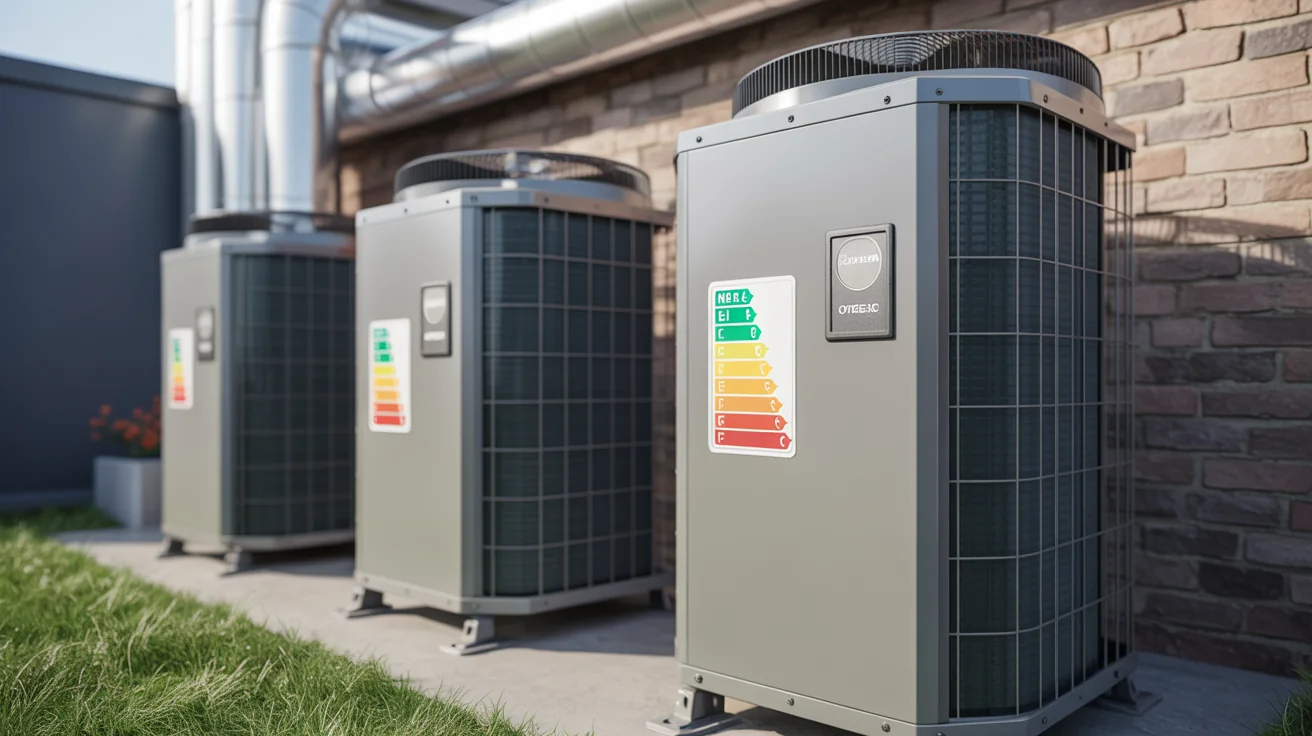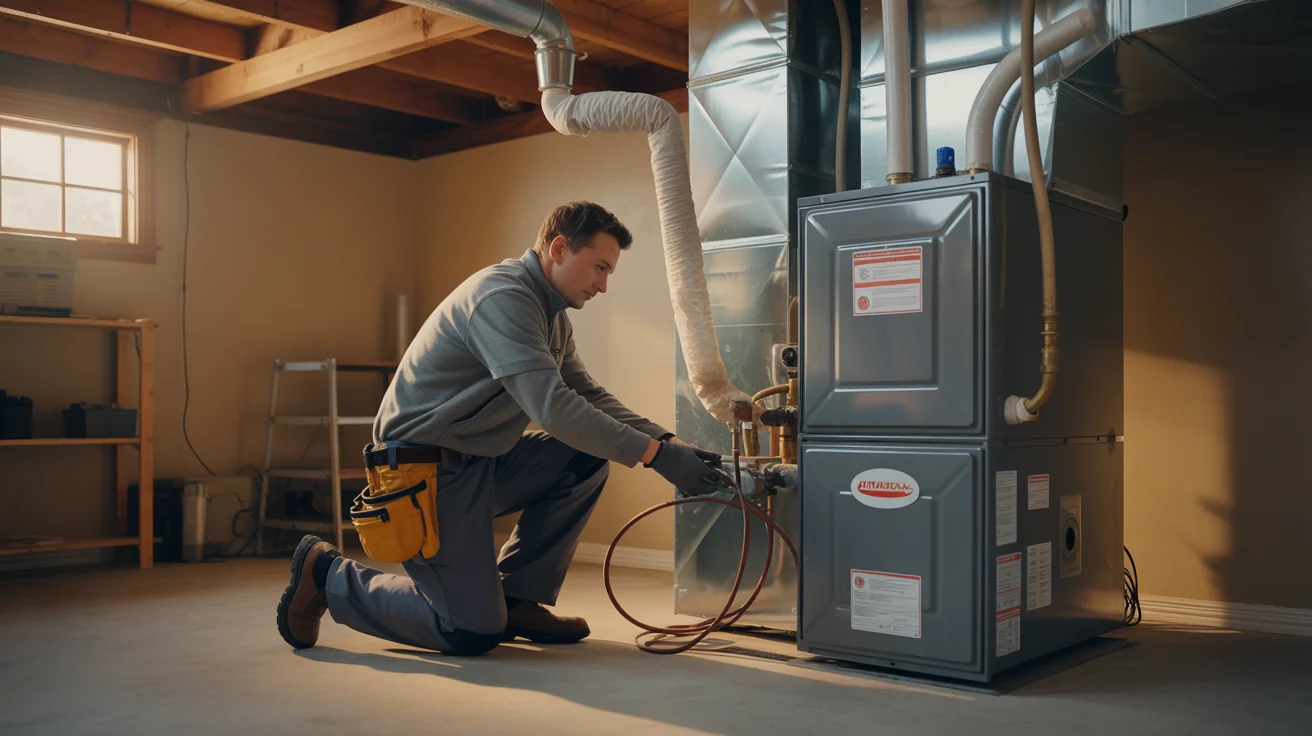Fall Heating System Preparation Guide North Texas 2025: Winter Readiness Protocol
Complete fall heating system preparation for North Texas. Pre-winter maintenance, safety checks, and efficiency optimization before cold weather arrives.

The Thanksgiving Call That Haunts Every HVAC Tech
Thanksgiving 2019. I’m carving turkey with my family when my phone rings. Mrs. Rodriguez in McKinney, crying. Her whole extended family is in town from California, it dropped to 28°F overnight, and her furnace is deader than roadkill.
When I got there that Thursday morning, the scene was heartbreaking. Twenty-three people huddled in the living room. Three space heaters running from Home Depot - $200 worth - and the house still couldn’t break 62°F. Babies crying, elderly grandparents shivering, and a ruined holiday.
The culprit? A heat exchanger cracked right down the middle. Not just expensive - dangerous. Carbon monoxide waiting to happen.
“How long has this been broken?” she asked through tears.
Truth? Probably since August. Heat exchangers don’t just suddenly crack - they develop hairline fractures during summer stress, then fail catastrophically when you need them most.
The emergency repair cost her $1,800 on a holiday. The real tragedy? A $150 fall service call would have caught this in September when we could have fixed it properly for $400, or at least given her family time to plan.
This scene repeats every November. First cold snap, my phone explodes. Six months of neglect finally coming home to roost.
Why North Texas Breaks Heating Systems in Unique Ways
I’ve worked on furnaces from Minnesota to Arizona, and nowhere - NOWHERE - do heating systems fail like they do here. We’ve got our own special brand of equipment torture.
Our Weather is Certifiably Insane
I once watched the temperature drop from 85°F to 35°F in eighteen hours. Your furnace has been taking a six-month vacation since April, and suddenly it’s expected to fire up and heat a house in conditions that would stress equipment anywhere.
Components that were perfectly fine yesterday are now dealing with thermal shock that would make an engineer cry.
Clay Soil is a Silent System Killer
This sounds crazy until you see it: our clay soil moves. A lot. I’ve found gas lines pulled loose and ductwork connections separated just from ground movement. It’s not earthquake-dramatic, but six months of drought followed by fall rains shifts everything.
The Golden Rule I Learned the Hard Way
NEVER test your heating system for the first time when it’s actually cold outside. I learned this during my second year when everyone’s heat failed on the same 28-degree night. No parts available, every tech booked solid for a week, and families freezing.
Test your system in October when it’s 60°F outside. If something’s broken, we can fix it calmly, get parts easily, and you’re not competing with every other family whose furnace just died.
What Actually Happens When Your Furnace Wakes Up
The Rude Awakening
Imagine sleeping peacefully for six months, then someone dumps ice water on you and demands you run a marathon. That’s what we do to heating systems in North Texas:
System Startup Stress Factors:
System Startup Stress Factors:
Gas valves and controls may stick after extended dormancy, preventing proper ignition or creating dangerous operating conditions that threaten family safety. Electrical components suffer from humidity and temperature cycling throughout North Texas summers, leading to corrosion and connection failures that affect system reliability. Heat exchangers expand rapidly when first heated, potentially revealing cracks that developed during the off-season and create carbon monoxide hazards. Blower motors struggle with dust and debris accumulation that builds up during months of inactivity, reducing efficiency and potentially causing motor failure. Thermostats may lose calibration during non-use periods, affecting temperature control accuracy and system response when heating is needed most.
Climate-Specific Challenges:
Climate-Specific Challenges:
Freeze-thaw cycles damage outdoor heat pump components through ice formation and thermal cycling that stresses refrigerant lines and electrical connections beyond design limits. High humidity summers corrode electrical connections and create moisture problems that affect system reliability and safety throughout the heating season. Dust and allergen seasons clog filters and components with debris that reduces airflow and efficiency while potentially damaging sensitive parts of the system. Clay soil movement shifts gas lines and affects ventilation systems through foundation movement that can disconnect joints and create dangerous conditions requiring immediate professional attention.
Heating System Types in North Texas
Gas Furnaces (65% of North Texas homes):
Gas Furnaces (65% of North Texas homes):
Gas furnaces operate on natural gas or propane fuel, providing reliable heating throughout North Texas winters with proven performance and consistent comfort delivery. These systems offer 80-98% efficiency ratings available across different models, from standard efficiency units to high-efficiency condensing furnaces that maximize fuel utilization. Annual safety inspection is required to ensure safe operation and prevent carbon monoxide leaks or other dangerous conditions that threaten family health. Carbon monoxide risk increases significantly if poorly maintained, making professional service essential for family safety and system reliability throughout the heating season.
Heat Pumps (25% of installations):
Heat Pumps (25% of installations):
Heat pumps provide electric operation with dual heating and cooling capabilities, making them versatile systems perfect for North Texas climate variations and year-round comfort needs. These systems operate efficiently in mild North Texas winters, often providing heating at 200-300% efficiency compared to electric resistance heating and reducing energy costs significantly. Defrost cycles become necessary during freezing weather to remove ice buildup from outdoor coils that can block airflow and reduce performance during cold periods. Backup electric heat activates during extreme cold when heat pump efficiency drops, ensuring consistent heating even during North Texas’s coldest periods when families need reliable warmth most.
Hybrid Systems (10% growing segment):
Hybrid Systems (10% growing segment):
Hybrid systems combine a heat pump with gas furnace backup, providing the best of both heating technologies in one integrated system that maximizes efficiency and reliability. Automatic switching based on efficiency allows the system to choose the most cost-effective heating method based on outdoor temperature and utility rates for optimal cost control. This configuration works optimally for North Texas temperature range, using the heat pump during mild weather and switching to gas heating when temperatures drop below efficient heat pump operation. Higher initial cost is offset by maximum efficiency throughout the heating season, providing long-term savings and optimal comfort through the most appropriate heating method for conditions.
My Personal Fall Heating Checklist
Start with Safety - Because Nothing Else Matters If This Goes Wrong
Carbon Monoxide Check - Don’t Skip This
Carbon monoxide is called the silent killer for a reason. I’ve been to houses where families had headaches all winter and didn’t realize their furnace was slowly poisoning them.
Here’s what you need to do:
- Push that little button on every CO detector in your house. If it doesn’t chirp, replace the battery. If it still doesn’t work, replace the detector.
- Make sure you have one within 10 feet of your heating equipment. I don’t care if it looks ugly - your life is more important than your decor.
- Check the expiration date. Yes, CO detectors expire. After about 7 years, the sensors wear out. Replace them.
Look at Your Venting
Walk outside and find where your furnace vents to the exterior. I’ve found bird nests, wasp nests, and once, memorably, a cat (don’t ask). Any blockage is dangerous.
Inside, look at the vent pipes. Any rust? Loose connections? Pipes that look like they’re sagging? These are problems that need fixing before you fire up the system.
Gas Line Safety Assessment:
- Inspect visible gas lines for damage or corrosion
- Check connections for tightness (no tools—visual only)
- Smell test near gas meter and appliances (gas odor = emergency)
- Document any concerns for professional inspection
Step 2: Air Quality and Filtration (20 minutes)
Air Filter Assessment:
- Remove old filter and inspect condition
- Measure filter dimensions for proper sizing
- Install new high-efficiency filter (MERV 8-11 recommended)
- Check filter housing for gaps or damage
Ductwork Visual Inspection:
- Look for visible disconnections from summer settling
- Check accessible ducts for damage or deterioration
- Verify all return air grilles are unobstructed
- Inspect for signs of pest intrusion or nesting
Phase 2: System Component Inspection
Step 3: Thermostat and Controls Testing (15 minutes)
Thermostat Function Test:
- Install fresh batteries if battery-operated
- Test heating mode activation and temperature control
- Verify proper display function and programming
- Check for loose mounting or wiring connections
Smart Thermostat Fall Setup:
- Update heating schedules for fall/winter occupancy
- Test remote connectivity and app functionality
- Verify learning features are adapting properly
- Enable auxiliary heat settings for heat pumps
Step 4: Indoor Unit Inspection (45 minutes)
Blower and Motor Assessment:
- Visual inspection of blower wheel for debris and damage
- Listen for unusual sounds during fan operation
- Check motor mounts and electrical connections
- Verify proper belt tension if belt-driven system
Heat Exchanger Visual Check:
- Look for visible cracks or corrosion (furnaces only)
- Check for rust flakes or metal debris
- Inspect flame observation ports for damage Warning: any suspected cracks require immediate professional service.
Electrical System Inspection:
- Check all visible wiring for damage or burning
- Test all electrical connections are tight (visual only)
- Inspect control board for signs of moisture or corrosion
- Verify proper grounding of all electrical components
Phase 3: Outdoor Equipment Preparation
Step 5: Heat Pump Fall Maintenance (30 minutes)
Outdoor Unit Cleaning:
- Remove leaves, debris, and vegetation around unit
- Clean coils with garden hose (inside-out spray pattern)
- Check refrigerant line insulation for damage
- Verify unit is level and securely mounted
Defrost System Preparation:
- Inspect defrost sensors and wiring
- Check defrost drain for proper drainage
- Test outdoor temperature sensor if visible
- Clear area around unit for proper airflow during defrost cycles
Step 6: Gas Furnace External Checks (20 minutes)
Venting System Inspection:
- Check external vent cap for blockages or damage
- Verify proper clearance from vegetation and structures
- Inspect vent pipe supports and mounting
- Look for signs of animal nesting or obstruction
Gas Meter and Line Inspection:
- Visual check of gas meter for damage or leaks
- Inspect exposed gas lines for corrosion or damage
- Verify gas shut-off valve operation (do not close unless emergency)
- Check regulator for proper function (visual assessment only)
When to Call Me (Or Any Good HVAC Tech)
The “Don’t Mess Around” List
Look, I appreciate the DIY spirit, but some things are just too important to gamble with:
You definitely need a pro if:
- Your system is more than 5 years old (I don’t care how handy you are)
- You see ANY rust, cracks, or damage to heat exchanger components
- You’ve had more than one repair call in the past year
- You just bought the house and have no idea when it was last serviced
- You smell gas, ever, anywhere, at any time
What I actually do during a fall service call:
I bring equipment you don’t have. My combustion analyzer measures carbon monoxide levels to parts per million. I check gas pressures with specialized gauges. I have cameras that can look inside heat exchangers for cracks you can’t see.
But honestly? Half of what I find wrong could have been caught by the homeowner if they’d just looked. The other half requires training and tools.
Performance Optimization:
- Gas valve calibration and adjustment
- Thermostat calibration verification
- Blower speed and airflow optimization
- Efficiency testing and improvement recommendations
- Motor lubrication and belt adjustment
- Electrical connection cleaning and tightening
- Control system testing and calibration
- Safety system verification and testing
Jupitair Fall Heating Service Menu
Comprehensive Fall Tune-Up ($185-$285):
- Complete safety inspection with CO testing
- Performance testing and efficiency optimization
- Preventive maintenance and lubrication
- Written report with recommendations
Heat Pump Fall Service ($225-$325):
- Refrigerant level check and leak detection
- Defrost system testing and calibration
- Electrical system inspection and testing
- Auxiliary heat system verification
Emergency Pre-Season Inspection ($149):
- Safety-focused rapid assessment
- Critical repair identification
- Same-day service availability
- Emergency repair options and pricing
First Cold Weather Operation Protocol
Safe Initial Startup Procedure
Pre-Startup Checklist:
- Verify thermostat set to heat mode
- Check that all vents are open and unobstructed
- Ensure new air filter is properly installed
- Confirm carbon monoxide detectors are functional
Initial Startup Monitoring (First 30 minutes):
- Listen for proper ignition sequence (gas systems)
- Monitor for smooth, consistent operation
- Check for unusual odors (slight dusty smell normal initially)
- Verify warm air production within 10-15 minutes
Performance Verification:
- Measure supply air temperature (should be 90-120°F for gas, 85-95°F for heat pump)
- Check for even heating throughout home
- Monitor for short cycling or frequent on/off operation
- Document any unusual sounds or performance issues
First Week Monitoring Protocol
Daily Checks (First 3 days):
- Monitor system startup and shutdown cycles
- Check for consistent temperature maintenance
- Listen for any new or unusual operational sounds
- Verify proper airflow from all supply vents
Weekly Assessment (First month):
- Review energy usage patterns for abnormal increases
- Test thermostat programming and automatic scheduling
- Check air filter condition (may need early replacement)
- Monitor outdoor temperature sensor function (heat pumps)
Common Fall Heating Issues and Solutions
Gas System Problems
Ignition Failures (28% of fall failures):
- Symptoms: Thermostat calls for heat but no ignition occurs
- Common causes: Dirty flame sensor, gas valve issues, ignition component failure
- Repair cost: $185-$450
- Prevention: Annual cleaning and calibration
Heat Exchanger Issues (15% of fall failures):
- Symptoms: Unusual odors, visible cracks, carbon monoxide detection
- Common causes: Age, overheating from restricted airflow, poor maintenance
- Repair cost: $800-$2,200 (often requires replacement)
- Prevention: Regular filter changes, annual inspection
Thermostat Problems (18% of fall failures):
- Symptoms: Inaccurate temperature control, no system response
- Common causes: Dead batteries, calibration drift, wiring issues
- Repair cost: $150-$350
- Prevention: Annual battery replacement, professional calibration
Heat Pump Challenges
Defrost System Failures (25% of heat pump issues):
- Symptoms: Ice buildup, reduced heating capacity, high energy bills
- Common causes: Faulty defrost sensors, control board issues, refrigerant problems
- Repair cost: $350-$850
- Prevention: Fall electrical system inspection
Auxiliary Heat Problems (20% of heat pump issues):
- Symptoms: Insufficient heat during cold weather, high energy costs
- Common causes: Faulty electric heating elements, sequencer problems
- Repair cost: $250-$650
- Prevention: Annual electrical system testing
Refrigerant Issues (15% of heat pump issues):
- Symptoms: Poor heating performance, ice formation, high energy bills
- Common causes: Leaks from summer operation, low charge
- Repair cost: $400-$1,200
- Prevention: Annual refrigerant level check
Energy Efficiency Optimization for Winter
Related: Energy Efficiency
Optimal Thermostat Settings
Recommended Fall/Winter Programming: Home occupied: 68-70°f during day. Home unoccupied: 62-65°f (8+ hour periods). Sleep settings: 65-68°f for comfort and efficiency. Vacation settings: 55-60°f (minimum to prevent freezing).
Heat Pump Specific Settings:
- Avoid frequent temperature adjustments (causes auxiliary heat use)
- Use gradual temperature changes (2°F per hour maximum)
- Enable outdoor temperature lockout to improve efficiency
- Set auxiliary heat differential properly (2-3°F recommended)
Winter Efficiency Improvements
Immediate Efficiency Gains:
- Reverse ceiling fans to push warm air down
- Seal air leaks around windows and doors
- Add insulation to accessible ductwork
- Install programmable or smart thermostat if not present
Seasonal Efficiency Strategies:
- Use natural solar heat gain during day
- Close blinds and curtains at night for insulation
- Ensure proper attic insulation and ventilation
- Consider zoning systems for large or multi-story homes
Emergency Preparedness for Winter
Cold Weather Emergency Kit
Essential Emergency Supplies:
- Battery-powered carbon monoxide detector
- Portable space heaters (electric only - properly rated)
- Extra blankets and warm clothing
- Flashlights and batteries
- Emergency contact information including Jupitair: (940) 390-5676
Emergency Response Protocol:
For Complete Heat Loss:
- Check thermostat settings and battery
- Verify circuit breakers haven’t tripped
- Check air filter for severe blockage
- Call for emergency service if no obvious solution
- Use safe temporary heating while awaiting service
For Carbon Monoxide Alarm:
- Evacuate home immediately
- Call fire department (911)
- Do not re-enter until cleared by authorities
- Have heating system professionally inspected before use
Winter Storm Preparation
Pre-Storm Checklist:
- Test heating system operation before storm arrival
- Clear outdoor units of debris that could become projectiles
- Insulate exposed pipes to prevent freezing
- Prepare backup heating plan for power outages
During Storm Protocols:
- Monitor heating system performance for unusual operation
- Keep outdoor unit clear of snow and ice accumulation
- Maintain adequate ventilation for combustion air
- Never use outdoor grills or generators inside for heating
Frequently Asked Questions
Q: When should I switch from AC to heating mode? A: Switch when overnight temperatures consistently drop below 60°F or when daytime heating is needed for comfort. Test heating mode during mild weather first.
Q: Why does my house smell dusty when I first turn on the heat? A: Normal accumulation of dust on heat exchangers and components during dormant season. Smell should disappear within a few hours. Persistent odors require inspection.
Q: Should I close vents in unused rooms to save energy? A: Generally no. Most North Texas systems are designed for balanced airflow. Closing vents can cause pressure imbalances and reduce efficiency.
Q: How often should I change my air filter during heating season? A: Check monthly, replace every 30-90 days depending on filter type, home occupancy, and pets. More frequent changes may be needed during high-use periods.
Q: What temperature should I set my thermostat when away from home? A: Set to 62-65°F for extended absences. Never set below 55°F in North Texas to prevent pipe freezing and maintain reasonable humidity levels.
Q: Do I need professional service if my system seems to work fine? A: Yes, annual professional service is essential for safety verification, efficiency optimization, and warranty maintenance, especially for gas systems.
Don’t Be That Thanksgiving Emergency Call
Every year, I spend Thanksgiving and Christmas responding to emergency calls that could have been prevented with an hour of attention in October. I don’t mind helping families in crisis, but I hate seeing people spend triple the money and deal with the stress when it was completely avoidable.
Here’s what I want you to do:
If you’re the handy type, use this checklist and take care of what you can safely handle. If you see anything that concerns you, including any rust, strange smells, or weird sounds, stop immediately and call a professional rather than risk safety or equipment damage.
If you’re not the handy type, or your system is older, or you just want peace of mind, call me now while the weather’s still nice and we can address any issues without the pressure of emergency conditions.
Ready to avoid being a holiday emergency?
Call (940) 390-5676 and let’s get your heating system checked before you actually need it.
I serve all of North Texas - Frisco, Plano, McKinney, Allen, The Colony, Little Elm, and everywhere in between. My maintenance customers get priority scheduling and never pay emergency rates.
Remember: The best heating emergency is the one that never happens. A $200 fall service call beats a $2,000 Thanksgiving disaster every single time.
Last updated: August 2025 | Based on 15+ years North Texas heating service experience | Serving 50,000+ satisfied customers
Jupitair HVAC: Licensed & Insured, and your North Texas heating specialists. Professional installation, repair, and maintenance since 2008.
Need Professional HVAC Service?
Our certified technicians are ready to help with any HVAC needs in North Texas



